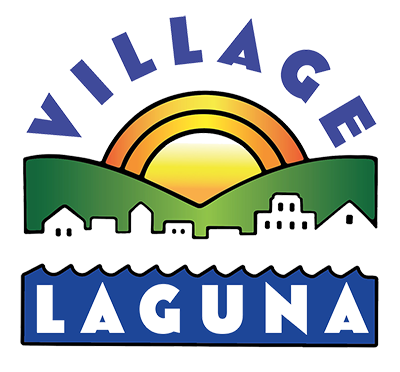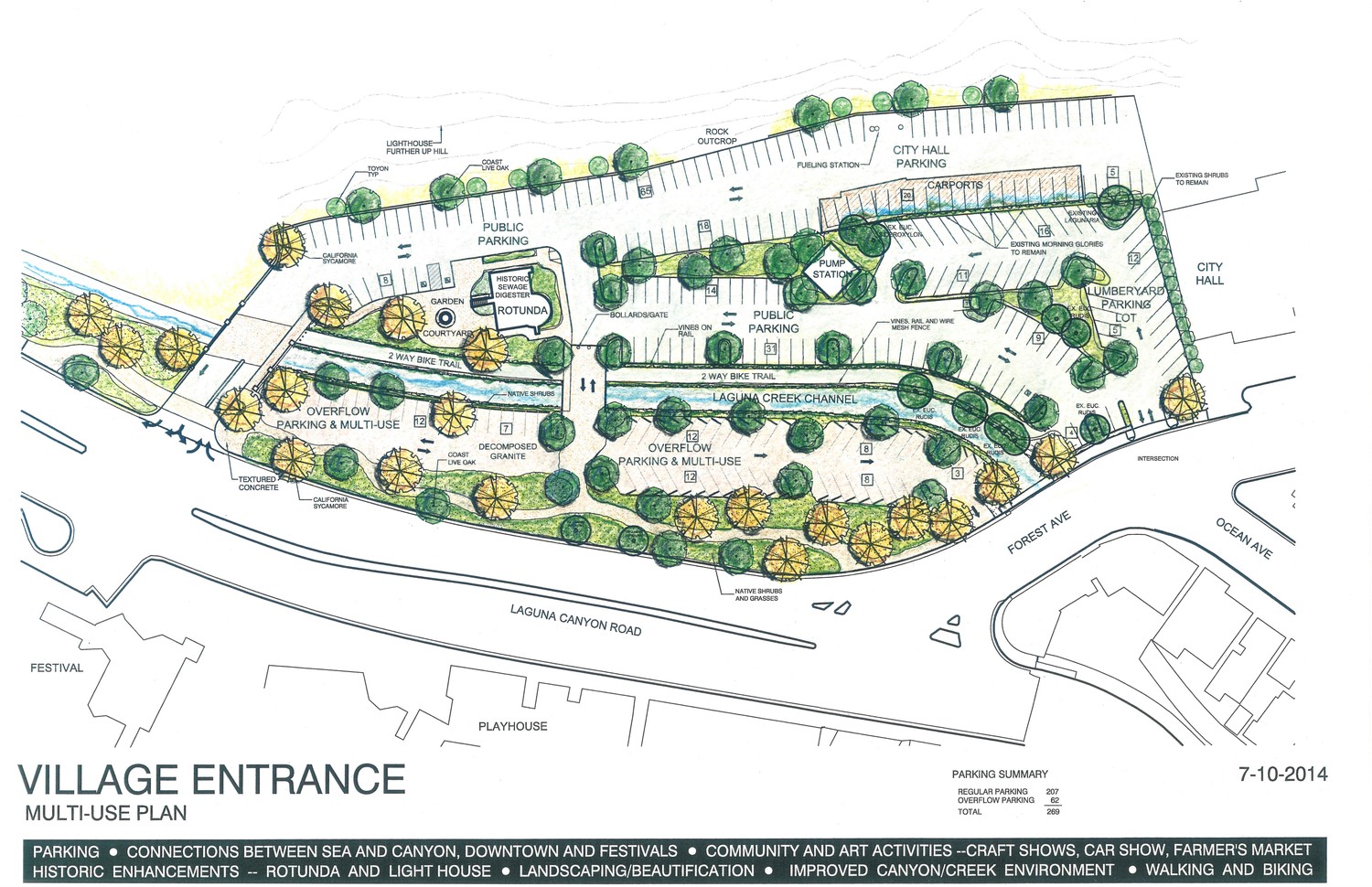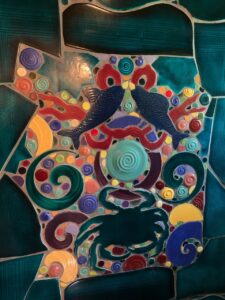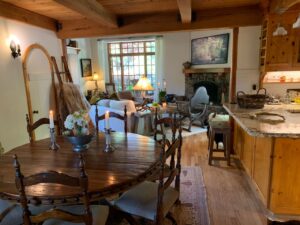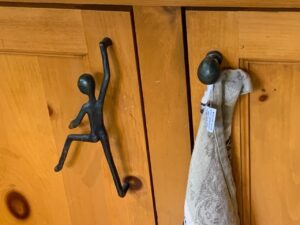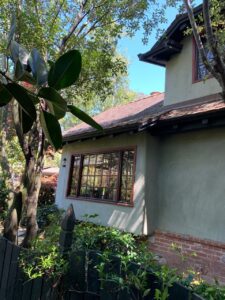Village Entrance
The Village Entrance Project, envisioned for more than 20 years as providing parking and a park on the property adjacent to City Hall in Laguna Canyon, returned to the City Council last year in the form of a massive parking structure that would have indebted the City for years and that violated many residents’ sense of what is an appropriate addition to our downtown. Village Laguna was active in the coalition that eventually persuaded the Council to abandon the parking structure proposal and then joined others in helping to decide what should replace it.
The Council chose an alternative that involved preserving nearly all of the surface parking on the site, reserving a 30-foot-wide strip for landscaping and a pathway linking downtown with the art festivals, and reducing the rehabilitation of the historic sewer digester tower to a superficial facelift. Participants in a well-attended public meeting were unanimous in calling for restoration of the tower, but at a later meeting the Council rejected this advice.
At both these meetings Village Laguna, in addition to urging restoration of the tower, presented a modification of the proposal that would remove some of the parking spaces to allow a more pedestrian-friendly entry to the pathway through the site.
Village Laguna’s proposal for the village entrance was described as follows:
The Village Entrance Multi-use Plan creates an attractive village entrance that serves multiple uses—for the community and for visitors.
Frequently used parking is concentrated on the east side of the creek and a two-way bike path is provided there where it does not conflict with pedestrians. The west side (next to Laguna Canyon Road) is open for an inviting, undulating pathway, landscaping and overflow parking (in unstriped spaces on a permeable surface). This overflow area is multi-use, for parking in summer and for public events (crafts/art shows, car show, expanded market, etc.) through the rest of the year.The historic sewage digester building is restored and a garden courtyard enhances it.The creek remains uncovered, with attractive fencing and landscaping.Existing trees are preserved and more are planted.The Farmer’s Market continues at the Lumberyard lot. The sheds with their morning glories continue to screen and beautify the lot
One source of inspiration is the Los Rios Park in San Juan Capistrano–its decomposed granite parking lot, wood wheel stops, native plants, boulders, and textured concrete paving. These elements/or similar are suggested in the overflow parking area and landscaping on the Laguna Canyon Road side of the channel.
Parking Summary
Parking spaces shown on plan
-
-
Regular parking 207
-
Overflow parking 62
-
Additional spaces not shown on plan
-
-
Overflow parking (strip along LCR) 39
-
Recently purchased building 7
-
Recently purchased lot 68
-
Proposed parking spaces 383
-
Existing parking spaces 392*
-
*Parking Stall Designation Plan, City of Laguna Beach, Public Works Dept. November, 2010
Information on the city’s website
Bob Borthwick’s Sept. 2019 Letter To Mayor Whalen and Councilmembers concerning Digester Building:
This award-winning 1930’s structure has been an iconic feature of the Village Entrance for 85 years and has endured all of the various plans to redevelop the site over the past decades.
I urge you to adopt Option Three as proposed by Staff, to create a beautiful, functional, and valuable public amenity in this highly-visible location. I am currently working on the restoration of the final 17 Cottages at Crystal Cove State Park, and I am also working on the refurbishment of the historic Fox Theatre block in downtown Fullerton. By comparison, I can assure you that to restore our Digester for $1.699 million [including public restrooms] is a huge bargain and a financial windfall for our town. Much less significant new structures can far exceed that cost.
If leased at market rates to a specialty coffee shop or a light-dining restaurant like Zinc Cafe, it could be a permanent income stream and would pay off the entire public investment within a decade or so. After that, it would be a cash cow for the City in perpetuity. A positive byproduct would be creating an attractive, activated space in the middle of the VE parking lot.. A win-win for everybody.
If the City chose to retain a public use for the building, it could be a Visitors Center, public art gallery, Arts Center, or Children’s Museum, among other potential uses. The historic 1918 Munitions Facility in Alexandria, Virginia became the nationally-acclaimed “Torpedo Factory Art Center” in 1974, and in Corona del Mar a former mortuary has been converted into a popular restaurant. Past uses are in the past, and are irrelevant to building re-purposing. Progressive cities create new and innovative uses for historic structures, they don’t demolish them for parking lots like they did in the 1950’s.
This building is a community real estate asset that we need to preserve for our generation and for future generations. Its potential is simply too valuable to waste.
Respectfully, Bob Borthwick
Village Laguna’s September 9, 2019 Letter to the Arts Commission re the Fornes Pavilion structure
You’ve heard a lot of objections to this project, and we appreciate your decision to try to explore some of them with the artist before recommending it to the City Council, but we’d like to see you take one more step back. Whatever the merits of the design, this is the wrong place for the Fornes structure, and we encourage you to accept that fact now and start looking for other public art options.
In all the thirty years it has taken to realize the community’s vision of the Village Entrance, there has never been talk of an assembly structure of this size. The vision from the beginning was of a green, quiet, pedestrian-friendly space, and the final plan sacrificed parking spaces to produce the landscaped areas it has today.
The structure you’re looking at has been appropriately described as not an art piece but a building, and installing it would require ripping out the existing landscaping, certainly at considerable expense, and apparently removing an elegant rammed-earth seating area that echoes the wall across the street at the Festival grounds.
You say that you’re simply following the recommendation of the cultural-arts placemaking study, but that study (which, unfortunately, was adopted after the final contract for the Village Entrance work was signed) suggests three possible places for a removable tent (not a building) that might shelter community activities on the site, only one of which includes the proposed location. One of the areas shown under such a tent is on the other side of the creek next to the historic digester, which many Lagunans would like to see repurposed as the kind of gathering place you have in mind. The Village Entrance is only one of several sites the study considers as a gathering place, the others being the Festival of Arts grounds (which is in fact a public park), the Sawdust Festival, and the Main Beach cobblestones. You’re not really required to build this thing right here.
Placing this giant installation in the narrow space between the highway and the creek would be a costly mistake, and it seems to us unlikely to meet your own expectations. In the many other cities that display the artist’s work, there’s generally more space available for its proper appreciation. As close as the structure will be to the highway, it may be hard to hear what’s going on inside the “pavilion,” and holding events there would appear to raise a number of logistical problems (no restrooms, for one).
Please listen to what your fellow Lagunans are saying and let us enjoy the Village Entrance we’ve waited so long for.
Sincerely, Johanna Felder, President Village Laguna
Village Laguna’s August 7, 2018, letter to the City Council:
Last December 6th at the Village Enterance workshop, the minutes show that at Kelly Boyd’s suggestion, you decided to include a restoration of the outside of the historic sewage digester as part of the Village Entrance Project. Surprisingly, this part of the project wasn’t included in the plans that went out for bids, so you have before you only the plan for patching and painting that staff seems to prefer. Tonight’s staff report refers to and gives an estimate for work identified in a set of plans that Morris Skenderian drew up last year, but it doesn’t include those plans or any details that would allow evaluation of the cost estimate you’ve been offered. Since the staff report says that there won’t be access to the winding stairway to the roof, we suspect that the work doesn’t include restoring the original deck to the left of the tower, and we wonder what else might be missing. We hope that you’ll call for the required historical report to guide this work and then process the plans through the Heritage Committee as you would for any other such project. The task will be much easier than usual in this case because the City has the original plans and a detailed history of the construction and Morris’s list of things that need to be done to bring the building back to its original appearance.
Another part of the project that you requested in December and that also somehow became “optional” in the bidding process was replacing the chain-link fencing with something more pleasing. We think that the proposed replacement fencing is higher than it needs to be and may not be perfectly child-safe, and, besides that, it would cost nearly four times as much as chain-link. We’d like to suggest that you shop around for a more appropriate alternative, maybe the kind of fencing used at Bluebird Park.
As staff points out, the plans for these two items will have to be sent out for bids, and we recommend that, to avoid any further misunderstanding, you hold hearings on the proposals before that is done. At the end of that process we’d like to see the costs included in the base contract, as you originally intended, with funding identified for the whole package.
Sincerely, Johanna Felder, President, Village Laguna
Village Laguna’s February 2018, letter to the City Council:
The Board of Village Laguna wants to thank the Council for the direction you gave at the last hearing on the Village Entrance. Thank you for ensuring the restoration of the Digester building, keeping the permeable paving, diversifying the trees, rejecting the chain link fencing, and choosing elements that will echo the details of the Festival entrance area.
While you gave general approval to go ahead with the next stage of design development, we are concerned that several items should have further Councll and public scrutiny before the project is approved to go out to bid:
-
Tree preservation plan—to be clear that the maximum number of existing trees are being preserved.
-
Planting plan—to see how the changes described in general in the agenda bill are implemented.
-
Lighting fixture choices and layout—the choices and locations of lighting fixtures.
-
Fencing—to review the fencing design that replaces the chain link fence.
-
Details on the Digester restoration
Will you please direct that more detailed plans on these items come before you prior to finalizing the drawings?
Sincerely, Johanna Felder, President, Village Laguna
Village Laguna’s February 28, 2017, letter to the City Council:
Thank you for your positive comments on the multi-use plan for the Village Entrance prepared by a committee of Village Laguna and the Beautification Council. Your reducing by 25 the number of parking spaces and allowing for 25% compact spaces will provide more space for planting and for a meandering pathway. This can result in a more aesthetically pleasing layout. It’s an important step in fulfilling the longstanding goals of the Village Entrance design.
However, we suggest that you additionally direct the consultants to take full advantage of the provisions in our parking code that can further reduce the space taken up by parking without reducing the parking count.
25.52.012 (E) Compact, Motorcycle and Bicycle Stalls. In every parking area and garage containing six or more stalls, fifty percent of the stalls provided may be designed as compact spaces. Bicycle and motorcycle parking spaces are encouraged and will count towards required parking. To count toward required parking, eight bicycle spaces or two motorcycle spaces count for one standard size parking space, not to exceed ten percent of the required parking.
In addition there are important aspects of the plan we ask that you continue to consider:
1. Making the open paved area (now shown as only a parking lot) between the channel and Laguna Canyon Road an open multi-use plaza used primarily for various activities such as art and craft exhibits, car shows, Farmer’s Market, etc. would provide overflow parking—only when the Christmas Tree and all the other lots are filled would it be used for parking. Thus for much of the year this space would be seen as part of the landscaped open space. It is important for this area to have paving that reinforces the rustic theme and its special multi-use status—not asphalt or plain concrete. We should look at the paving the consultant is recommending to see if it would meet this criterion. We should visit Los Rios park in San Juan Capistrano to see how the paving there is faring.
2. There is little benefit in removing the rusty sheds and much to lose. Laguna Beach is known for its history and its quirky features around every corner. The sheds and morning glories are a subtle reminder of the character of our town in earlier times. These are the kinds of buildings the plein air painters loved to paint. The extra-long parking spaces under the shed roof can continue to be used for City vehicles. Trading that extra parking area for an expanded landscape zone is unnecessary, since its only function is to hide what is already well hidden by the existing sheds.
3. At earlier planning sessions there was strong public support for restoring the digester tower. A number of ideas have been suggested for beneficial uses of the building, and surely we can agree on future uses in the coming months.
If the digester is not restored now, it appears that we will have to wait for the completion of the rest of the project in 2020 to do it. At that point the work will be disruptive of the new improvements on the site, and it will probably cost more than it would otherwise to coordinate the necessary changes in water, sewer, and electrical service to the building (which may be the logical place for lighting and irrigation controls for the rest of the site). In any case, whatever reuse of the digester is chosen, the restoration of the exterior can go ahead in the meantime, being determined by the original plans for this historic building. We have already paid architect Morris Skenderian to research and produce plans for the restoration work. His work is fundamental to preparing the detailed plans. If we stop the restoration now, that investment in his services will be lost, and in three years or more an architect will have to get up to speed on this building all over again. Now is the time to complete the restoration and make the building more beautiful and functional.
The restored digester can be a focal point of the project, offering opportunities for cultural and historical exhibits as well as possibly a Chamber of Commerce office/visitor information center. Permanent restrooms at that, location would also facilitate the activities in the plaza. This would help to bring life to the whole project. Instead of just parking and landscaping, a renewed historic center with related outdoor amenities (as shown on our multi-use plan) will give the Village Entrance area an image and focal point. This 1926 painting by George Brandriff shows the array of cottages and sheds prevailing in town at the time the Presbyterian Church was under construction. Our sheds are some of the last remaining artifacts with the character of that era. We should repair and reinforce them while leaving their downhill appearance with the morning glories intact.
4. The City should get its money’s worth, and you are being responsible in keeping close watch over expenditures. However, just as you recognized as the project developed that the rigid criterion of preserving all of the parking spaces on the site was limiting the aesthetics of the design, so should we also allow a budget that is adequate to fund a well-executed and beautiful project—one about which there will be no regrets. Please do not view this as Phase I of some future project. The project you decide upon will in all likelihood be in place for decades.
Thank you for considering further enhancements to the Village Entrance design. We look forward to working with you toward a project that will be admired well into the future.
Sincerely,
Johanna Felder, President, Village Laguna
Ruben Flores, Chair, Laguna Beach Beautification Council
Gregg DeNicola. President, Laguna Beach Historical Society
Village Laguna’s February 1, 2017, letter to the Planning Commission and City Council
Twenty-two years ago, when this project first started, the vision was “a beautiful, pedestrian-oriented area that links the art festival activity areas to the downtown village and Main Beach.” It was going to have a “pedestrian walkway that meanders through an undulating park-like landscape of indigenous trees and flowers and includes interesting art ‘placement’ sculptures and creative water features.”
The proposal we’ve ended up with is very far from that vision.
The pathway isn’t wide enough or protected enough from the Canyon Road to create the green space we’ve been hoping to see, and that’s because preserving the parking spaces has been the guiding principle for its design.
The plan that Ann and Ruben are talking about shows how more green space could be created. The curving shape of the pathway on that plan would be better buffered from the road and would mirror the new Festival façade. The metal sheds would echo some of the materials across the street and remind us of an earlier time.
That plan would require giving up some parking spaces, but if that proves to be a problem with the Coastal Commission we think you could make a good case that the City is making up for the slight shortfall elsewhere.
You could point, for example, to the fact that you’ve spent $5 million on the Christmas tree lot and will be spending another million upgrading it to provide additional spaces. You could mention the peripheral parking lots at the hospital, Pavilions, ACT V, and LCAD, the free shuttle, and the electronic billboards encouraging its use.
Also, we hear that tourists are arriving at their hotels by Uber and using it to get around town while they’re here. And a good-looking pedestrian pathway could even be considered a visitor-serving amenity.
A lot of people are going to be disappointed to find that after all this work we’re going to have just a parking lot with a few more trees in it.
We urge you to free up enough space for a meandering pathway away from the road that will make the Village Entrance beautiful and welcoming.
Sincerely, Johanna Felder, President, Village Laguna
<Read Ann Christoph’s column from the Laguna Beach Independent, February 17, 2017
Laguna Beach Magazine, Sept. 2, 2016.>
Village Laguna’s June 30, 2016, letter to City Council:
On June 4, after attending the last consultant-directed workshop on the Village Entrance project, we wrote you the attached letter advising you that it seemed to us the project was going down the wrong track. We asked you to take action to address problems arising from applying criteria to the design that did not allow the consultants to consider certain features that would improve it.
Unfortunately, the consultant’s presentation of the community’s input lists the number of participants but doesn’t summarize the recommendations they made. Allowing the project to continue with the flawed criteria has meant that the consultants have spent another three months preparing a presentation that does not meet the expectations of the members of the public who participated in the process.
Rigid adherence to providing 397 parking spaces and saving space for some undefined future building have prevented the consultants from coming up with alternatives that provide more open landscaped and activity space and more beauty at this important to the entrance.
Reducing the number of required parking spaces would be consistent with the Council’s action on the Festival Grounds remodel (allowing the Festival to remove spaces) and could be justified to the Coastal Commission with reference to our shuttles and peripheral parking arrangements.
During the discussion of the “Sendero” plan with a parking garage at the Christmas tree lot, members of the public suggested that, if a structure is to be considered, a location for two levels could be behind the Lumberyard lot on the east corner of the property next to the back of City Hall. We were told that that area was being reserved for some future project. This constraint had as not previously been discussed in the workshops.
We urge you to remove these two constraints and allow the consultants to produce options that increase the “park” landscaped open space for pathways and activities on the Broadway side of the channel.
While we do not support either of the submitted design concepts, we enthusiastically support the following components of the plans:
-
Restoration of the sewage digester building.
-
Landscaping along channel and along the street frontage.
-
Removing the chain link fencing along the channel and replacing it with a post and rail system.
-
Improved bridge connecting the 2 sides of the channel.
-
Planting and multi-use pathway connecting the main part of the project to the Christmas tree lot and Art-a-fair area.
-
The pavement shown in the evocative images of Slides 22, left side, and 58.
Finally, we offer the following detailed critique of the project:
-
The project doesn’t note existing trees to be saved along the channel, in the Lumberyard lot and along Broadway, and the renderings show no or fewer trees in these areas. The existing trees should be saved.
-
More shrub planting is needed next to the channel. (Slide 35 shows no shrubbery next to the rail.)
-
More trees are shown on the plan view (Slide 15) than in the perspective view (Slide 17).
-
Slide 15 shows green landscaping around the sewage digester building, yet Slides 17 and 27 show pavement. There should be planting around the building except for needed access paths.
-
Creative shade structures should be simple, rustic, and not distracting from the overall canyon feel. (Slide 41 is too industrial and the cactus on top is out of place; Slide 42 is a more appropriate example.)
-
Slide 45 still shows all the bottlebrush trees in the median, while the median recommendation is to remove some of them.
-
Slide 48 shows other trees mixed in with the bottle-brush trees in the median. What are they? In general, the median proposal needs further explanation.
-
Slide 52 (Sendero) shows more open/non parking area, but much of the space gained is devoted to more paving. More planting would be preferred.
-
It would be preferable to have much less or no parking on the Broadway side of the channel so there could be a park there. Instead the Sendero plan adds more landscaped space on the inland side of the channel, leaving a large area of parking on the Broadway side. (Slide 52). A new channel bridge next to Forest Avenue would not be needed if there is no parking between the channel and Broadway.
-
The additional restroom (Slide 53) might be incorporated into the sewage digester building instead of placed on the Broadway frontage.
-
The rusty sheds and morning glories are not saved in either option, and it appears to us that there is no reason to take them down.
Please provide direction to the consultants that follows our recommendations and comments.
Sincerely, Johanna Felder, President, Village Laguna
Village Laguna’s June 4, 2016, letter to the City Council:
The Board of Village Laguna would like to express our concerns regarding the progress of the Village Entrance planning as presented at the public workshop of April 13. We have given some thought to the presentation and plans proposed and we are concerned that our community input and planning efforts are being manipulated off of the public stage. This seems to be producing results that will be, in the end, not acceptable and too costly for the benefits given.
At the prior workshop the consultants were open to a wide range of ideas from the public, but at this workshop it was clear that they had been given strong constraints from the city that limited their planning results.
This has resulted in two plans that are both unacceptable because they lack green space and a park-like atmosphere. They have had to adhere strictly to a certain quantity of parking spaces, even though council members stated at the time the Festival Entrance Plan was approved without on-site parking, that the Village Entrance planning could also allow flexibility in the quantity of parking spaces provided.
The second plan, the “Sendero” plan, proposes a second level of parking on the Christmas tree lot in order to gain a small increase in park-like space. If there is to be a structure, this seems to be a poor location for it as it will be highly visible, and the furthest away from areas where parking is needed year-round. If a second small level of parking is to be considered, it could be at the eastern/back part of the site nearest to city hall where the topography already provides two levels. There a small structure could be designed to be little noticed and it is in a convenient location for parking. When members of the public asked about that location the consultants explained that this area was reserved for some “future building.” This “future building” idea is a new criteria apparently inserted privately by the city, as it was not directed in the public workshops.
We are concerned that the consultants are not allowed to use full public input or their best professional judgment in designing the Village Entrance. Please reduce the number of parking spaces that are required and remove the constraints related to the undefined “future building” so that they can produce plans that meet our goals for a green and beautiful Village Entrance area.
Sincerely, Ginger Osborne, Acting President, Village Laguna
Village Lagunas April 13, 2015 Letter to the City Council re Agenda Bill #14, Contract Award for Village Entrance Design Team:
We urge the Council not to approve the proposed Contract Award.
Choosing an engineering firm to design the Village Entrance at this stage would be putting the cart before the horse. The decisions before us should be based on aesthetics and the vision for relating the Village Entrance to the treasured qualities of our city rather than technical details. We need to be talking about enhancing the role of this key urban space as the heart and soul of the community rather than details of asphalt and concrete.
1. A concept design supported by the community needs to be developed before further detailed technical work proceeds.
2. The RFP and the resulting proposals from the consultants include many expensive technical tasks that go beyond the scope of “Concept” or “Schematic” design. Many of these tasks would ordinarily be part of “Design Development” or “Construction Documents.” The Agenda Bill says that the second version of th e RFP separated the concept work from the engineering details, but the revised document doesn’t reflect that.
Overly detailed technical components include:
-
Bridge design, including structural engineering
-
Demolition and grading plan
-
Drainage plan
-
Irrigation plan
-
Detailed design of the 725 Laguna Canyon Road parking lot, including demolition and grading plans, rock debris wall, retaining walls, landscape and irrigation plans, lighting plans, etc.
-
Detailed components of changes to Laguna Canyon Road as well as the medians, including detailed items such as “a plan for any traffic signal pole or control box relocations required by any of the proposed improvements.”
-
Develop drawings for the carport/screening design solution.
-
Structural system concepts including bridge abutments.
-
Electrical design solutions for lighting, power service and distribution, security, fire suppression and other special electrical systems.
-
Civil engineering for drainage, grading, storm water management, demolition plans, curb and gutter treatmentsAt this time the City should spend much less than the $400,000–$500,000 bid by the consultants. We can do this by concentrating on the design concept. Save the bulk of those funds for detailed technical design when the overall plan is clear and approved.
3. At this time the City should spend much less than the $400,000—$500,000 bid by the consultants. We can do this by concentrating on the design concept. Save the bulk of those funds for detailed technical design when the overall plan is clear and approved.
4. Community involvement outline in the proposal is inadequate (2 outreach meetings held after the conceptual site plan has been prepared—see page 52 of the Agenda Bill.)
5. There was no Council or public involvement in the content of the RFP. There was no Council/public review/interview of the potential consultants as there was with the selection of the urban designer for the Downtown Specific Plan.
We recommend that the RFP be revised to reduce the scope to true Schematic Design, including an extensive community involvement process. An Agenda Bill for the new RFP should be reviewed at a City Council meeting before being issued and there should be Council and public involvement in consultant selection.
Project Now Needs Creativity and Vision, not Engineering
In November 2013, the Council voted not to construct a parking garage at the Village Entrance. Alternative D, sketched out at the last minute as an example of how a path could be fitted into the existing parking layout, was referred to in the decision. Concerned that Alternative D, which makes minimal aesthetic/landscape improvements, would be the accepted plan going forward, Village Laguna joined with other groups to produce an alternative plan. This plan was presented to staff and the consultant from Griffin Structures, and subsequently at the public workshop of July, 2014. It was also presented at the Council meeting of September, 2014 when the Council directed that staff proceed with the Village Entrance consultant selection process. It was emphasized that the consultant would involve the community in developing an acceptable design for the Village Entrance.
We bring this history forward to emphasize that the design direction for the Village Entrance is not clear or definite. Yet the RFP given to the prospective consultants has many components that are very detailed and technical, much beyond the description of “Conceptual” and “Schematic” as listed on page 3 of the Agenda Bill.
Further Improvements Needed in the RFP
Some provisions of the RFP are unnecessarily rigid at this phase:
1. Requirement that 397 parking spaces be provided. Council members stated in earlier meetings that fewer spaces could be considered in order to have a superior design for the Village Entrance. Determining the balance of parking and landscaping is part of the Concept Design phase.
2. The RFP sets design criteria for the Laguna Canyon Road median that have not been reviewed or decided by the Council. The RFP states that large caliper trees are required for the median, even though the Council- approved Landscape and Scenic Highways Resource Document recommends low growing, drought-tolerant shrubs and ground covers. The Resource Document recommends no trees in the medians, with the large, majestic trees being planted on the sides of the road, in order to emphasize the feel of the Canyon and provide views of the mountains on each side. Insisting on large caliper trees in the median in violation of Caltrans policies (policies that are based on public safety) will add significantly to the complexity of design, the difficulty of approvals and the cost of construction.
The RFP requires the Consultant to do tasks that are open-ended and undefined, such as “Work with City staff to petition Caltrans to delegate to the City lead agency status.” (pp. 7 and 14) This adds to the price in the consultant’s bid since there are many factors and time expenditures that cannot be predicted. Perhaps lead agency status would not even be needed if the design didn’t include the large trees in the median.
Including work in the RFP that is not part of the Village Entrance project also adds to the costs, such as preparing drawings for storage buildings to be constructed behind City Hall to replace the temporary office trailers. This is a new component that does not relate to the basic scope of the Village Entrance plan and was not included in project descriptions up to this point.
Conclusion
Considering how controversial this project has been we recommend that the Council take the work one step at a time. Let’s have designs that are well-supported by the community before proceeding with technical work.
In order to do that we need a process that involves the community in meaningful ways, with consultants who have a design vision for making the Village Entrance a beautiful focal point that will inspire and give long lasting enjoyment.
Sincerely, Johanna Felder, President
